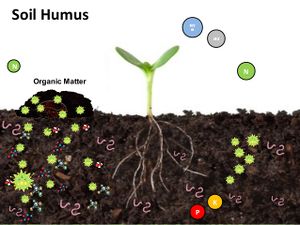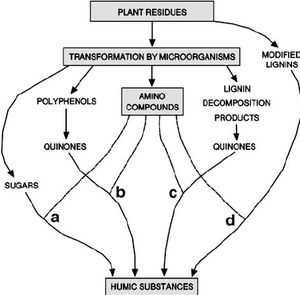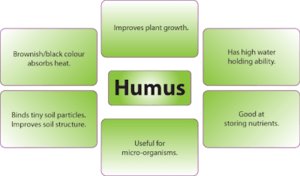Humus: Difference between revisions
m The LinkTitles extension automatically added links to existing pages (<a rel="nofollow" class="external free" href="https://github.com/bovender/LinkTitles">https://github.com/bovender/LinkTitles</a>). |
|||
| (38 intermediate revisions by 4 users not shown) | |||
| Line 1: | Line 1: | ||
[[File:hummus.jpg|thumb|right|This is hummus.. Not to be confused with humus]] [[File:soilhumus.jpg|thumb|right|This is humus!]]Humus is a type of soil created from decaying plants and [[organisms]]. Coined by a french [[soil]] scientist, Muller, the name is derived from the latin word "soil". Humus is difficult to describe and has yet to be fully understood. | |||
== | ==Description== | ||
Humus is non-living [[Organic Matter|organic matter]] within soil, derived from the microbial [[decomposition]] of plants and [[animals]]. [6] The substance left behind, known as humus, consists of approximately 60% carbon, 6% nitrogen, as well as small amounts of sulfur and phosphorus. Humus is generally dark colored, though there is observable variation in shade, highly influenced by climate. There is lighter humus coloration present across the tropics and subtropics, whereas humid-temperate zones produce darker and more intensely colored humus. In agricultural terms, humus can be described as well aged [[compost]]. [[Organic Matter|Organic matter]] decomposes molecules into smaller molecules by [[microorganisms]] in the soil. Most of the chemicals in this [[Organic Matter|organic matter]] can be extracted by microorganisms and can be shared with other beings within the soil. Humus has a wide variety of decay (ex. peatmoss, gradd, leaf compost, wood chips, decayed sawdust, garden waste, etc). [3] Humus has higher water adsorptive capacity than [[clay]]. It has a complex structure and has two main structural units; phenolic nature and nitrogen compounds. Humus also has low plasticity and cohesion. | |||
==Formations of humus== | |||
'''Mor''' | '''Mor''' | ||
''' | Mor is generally found in coniferous forests or mixed-wood forests. It is also associated with acidic conditions. Mor comes from [[decomposing]] [[Organic Matter|organic matter]] that lies on the surface of the soil. Fungi, earthworms, and small [[arthropods]] are some common organisms that decay into mor. Mor usually contains a low mineral content. The biological activity is relatively low, preventing decomposition of the [[Organic Matter|organic matter]]. Mor has a slow transformation and accumulation process of plant residue. [4] | ||
Moder is the transitional form of humus. | |||
'''Moder''' | |||
Moder is the transitional form of humus. It lies between mull and mor. This type of humus is moderately humified and has characteristics of both mor and mull. Moder can be found where mor or mull are not generally favorable. [5] | |||
'''Mull''' | '''Mull''' | ||
Mull can be found in hardwood forests, deciduous forests, or grasslands within warm, humic climates. Unlike mor, the pH in this humus formation is much higher, and larger [[insects]] are more abundant. Mull is subject to rapid decomposition and is well mixed with minerals [5] | |||
[[File:mor_moder_mull_picture.gif]] | [[File:mor_moder_mull_picture.gif]] | ||
== Humification == | |||
[[File:humification.png|thumb|right]] Humification is the process of formation of humic substances decomposed from plant remains. This is results from oxidation by addition of oxygen from oxygenated water and lowering the groundwater table, heat and exposure, and pH values of water in the peat. Fungi and microbes attack [[lignin]] that brings cells, fibers, and vessels of wood and converts them into humic substances. Kodel-Knabner has summarized the formation of humus as selective preservation of plant and microbial polymers, direct transformation and microbial resynthesis. Darker colors signify strong humification and lighter colors point to wetter periods and less humification. Humification accelerates at high temperatures. [7] | |||
==Benefits of Humus== | |||
[[File:humusb.png|thumb|right]] | |||
- Absorbs moisture, therefore it raises the temperature of the soil and can maintain its heat. [1] This can prevent the roots of plants from frosting during cold weather events. | |||
- Holds onto nutrients and can prevent them from leaching. | |||
- Can absorb moisture which can help soil during dry weather events. | |||
- Since humus can retain nutrients, this allows plants and organisms to thrive in the soil. Humus feeds the population of organisms living in it. | |||
- Can protect the soil from extreme temperatures. It also plays a huge role in soil fertility. | |||
- Humus' biochemical structure allows it to buffer excessive acid or alkaline soil conditions. This prevents toxic substances from entering the ecosystem. | |||
- Supports the growth of a very important organism called [[mycorrihizal fungi]]. This fungi has a symbiotic relationship with many plants and helps bind the soil particles together to form a sturdy soil structure. [2] | |||
- Is a source of nutrients for microbes, microscopic organisms with a vast number of species | |||
- Protects microbes | |||
- Influences the growth of root structure by improving vigor | |||
- Regulates [[soil pH]] levels to solve pH problems | |||
- Is a natural and safe way to build good soil structure | |||
- Reduces compaction | |||
- Suppresses diseases | |||
==References== | |||
1. Britannica, T. E. (2015, July 27). Humus. Retrieved from https://www.britannica.com/science/humus-soil-component | |||
2. What Role Does Humus Play in Soil Fertility? (2018, March 15). Retrieved from https://greentumble.com/what-role-does-humus-play-in-soil-fertility/ | |||
3. What is humus? - the secrete to great soil. (2017, March 22). Retrieved from https://www.gardenmyths.com/what-is-humus/ | |||
4. (n.d.). Retrieved from http://karnet.up.wroc.pl/~weber/typy2.htm | |||
5. (n.d.). Retrieved from http://forestfloor.soilweb.ca/definitions/humus-forms/ | |||
6. National Geographic Society. (2012, October 09). Humus. Retrieved from https://www.nationalgeographic.org/encyclopedia/humus/ | |||
7. Humification. (n.d.). Retrieved from https://www.sciencedirect.com/topics/earth-and-planetary-sciences/humification | |||
Latest revision as of 14:12, 5 June 2023


Humus is a type of soil created from decaying plants and organisms. Coined by a french soil scientist, Muller, the name is derived from the latin word "soil". Humus is difficult to describe and has yet to be fully understood.
Description
Humus is non-living organic matter within soil, derived from the microbial decomposition of plants and animals. [6] The substance left behind, known as humus, consists of approximately 60% carbon, 6% nitrogen, as well as small amounts of sulfur and phosphorus. Humus is generally dark colored, though there is observable variation in shade, highly influenced by climate. There is lighter humus coloration present across the tropics and subtropics, whereas humid-temperate zones produce darker and more intensely colored humus. In agricultural terms, humus can be described as well aged compost. Organic matter decomposes molecules into smaller molecules by microorganisms in the soil. Most of the chemicals in this organic matter can be extracted by microorganisms and can be shared with other beings within the soil. Humus has a wide variety of decay (ex. peatmoss, gradd, leaf compost, wood chips, decayed sawdust, garden waste, etc). [3] Humus has higher water adsorptive capacity than clay. It has a complex structure and has two main structural units; phenolic nature and nitrogen compounds. Humus also has low plasticity and cohesion.
Formations of humus
Mor
Mor is generally found in coniferous forests or mixed-wood forests. It is also associated with acidic conditions. Mor comes from decomposing organic matter that lies on the surface of the soil. Fungi, earthworms, and small arthropods are some common organisms that decay into mor. Mor usually contains a low mineral content. The biological activity is relatively low, preventing decomposition of the organic matter. Mor has a slow transformation and accumulation process of plant residue. [4]
Moder
Moder is the transitional form of humus. It lies between mull and mor. This type of humus is moderately humified and has characteristics of both mor and mull. Moder can be found where mor or mull are not generally favorable. [5]
Mull
Mull can be found in hardwood forests, deciduous forests, or grasslands within warm, humic climates. Unlike mor, the pH in this humus formation is much higher, and larger insects are more abundant. Mull is subject to rapid decomposition and is well mixed with minerals [5]
Humification

Humification is the process of formation of humic substances decomposed from plant remains. This is results from oxidation by addition of oxygen from oxygenated water and lowering the groundwater table, heat and exposure, and pH values of water in the peat. Fungi and microbes attack lignin that brings cells, fibers, and vessels of wood and converts them into humic substances. Kodel-Knabner has summarized the formation of humus as selective preservation of plant and microbial polymers, direct transformation and microbial resynthesis. Darker colors signify strong humification and lighter colors point to wetter periods and less humification. Humification accelerates at high temperatures. [7]
Benefits of Humus

- Absorbs moisture, therefore it raises the temperature of the soil and can maintain its heat. [1] This can prevent the roots of plants from frosting during cold weather events.
- Holds onto nutrients and can prevent them from leaching.
- Can absorb moisture which can help soil during dry weather events.
- Since humus can retain nutrients, this allows plants and organisms to thrive in the soil. Humus feeds the population of organisms living in it.
- Can protect the soil from extreme temperatures. It also plays a huge role in soil fertility.
- Humus' biochemical structure allows it to buffer excessive acid or alkaline soil conditions. This prevents toxic substances from entering the ecosystem.
- Supports the growth of a very important organism called mycorrihizal fungi. This fungi has a symbiotic relationship with many plants and helps bind the soil particles together to form a sturdy soil structure. [2]
- Is a source of nutrients for microbes, microscopic organisms with a vast number of species
- Protects microbes
- Influences the growth of root structure by improving vigor
- Regulates soil pH levels to solve pH problems
- Is a natural and safe way to build good soil structure
- Reduces compaction
- Suppresses diseases
References
1. Britannica, T. E. (2015, July 27). Humus. Retrieved from https://www.britannica.com/science/humus-soil-component
2. What Role Does Humus Play in Soil Fertility? (2018, March 15). Retrieved from https://greentumble.com/what-role-does-humus-play-in-soil-fertility/
3. What is humus? - the secrete to great soil. (2017, March 22). Retrieved from https://www.gardenmyths.com/what-is-humus/
4. (n.d.). Retrieved from http://karnet.up.wroc.pl/~weber/typy2.htm
5. (n.d.). Retrieved from http://forestfloor.soilweb.ca/definitions/humus-forms/
6. National Geographic Society. (2012, October 09). Humus. Retrieved from https://www.nationalgeographic.org/encyclopedia/humus/
7. Humification. (n.d.). Retrieved from https://www.sciencedirect.com/topics/earth-and-planetary-sciences/humification
